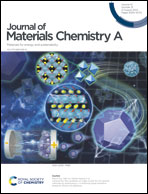Tailoring defect-type and ligand-vacancies in Zr(iv) frameworks for CO2 photoreduction†
Abstract
The nature and degree of defects can fine-tune the light absorption energy (Eabs) and charge transfer energy (ELMCT) of metal–organic frameworks (MOFs), which are important for photocatalytic reactions. Herein, a series of UiO-66-NH2 with missing-linker (ML)/missing-cluster (MC) defects and different degrees of ligand vacancies were synthesized and utilized to explore their photocatalytic performance of CO2 reduction. The photocatalytic CO yield of UiO-66-NH2-ML-100 with ML defects reaches 21.3 μmol g−1 h−1, which is 2.2 times that of UiO-66-NH2-MC-150 with MC. Both experiments and density functional theory (DFT) calculations demonstrate that the nature of MC defects enlarges Eabs, while the ligand vacancy changes the coordination environment of Zr(IV) and lowers ELMCT. More ligand vacancies per metal node lead to smaller ELMCT, which is beneficial for the CO2 photoreduction reaction. This work provides a pathway to boost photocatalytic performance by tailoring the defects of MOFs.



 Please wait while we load your content...
Please wait while we load your content...